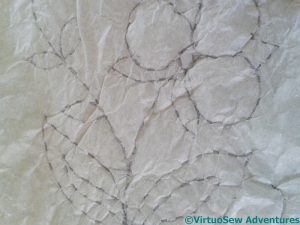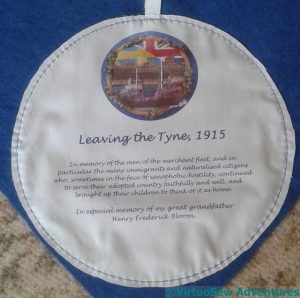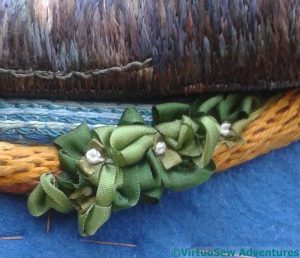Tag: design elements
The Jacobean Coat – getting started
This is going to be a truly multi-generational project. The design elements are stolen from a tablecloth my Grandmama did during the war, and I’m going to embroider it on a coat for my Mam (her daughter). I will write a post about Grandmama’s tablecloth one of these days, because it’s an absolute cracker, full of wonderful needlelace patterns I’ve never seen anywhere else. However, as it is stitched in white on white fabric, I will have to become a better photographer first!
You may recall that during the Great Lady’s Magazine Stitch-Off, I wrote a post about the different methods for transferring designs, particularly concentrating on their advantages and disadvantages in different circumstances. The fabric of the coat (this will be the second incarnation of this fabric!) is a pale green boiled wool. It’s dense enough to have some structure and weight, light enough to be easy to stitch (I think). You might have thought it would accept gracefully any method I chose.
However, when I thought about transferring the design, I found myself ending up with the most time consuming of the lot! Since the garment is unlikely to be washed, and rubbing may damage the surface, my options are somewhat limited. Transfer pencils spread, sometimes, if the ironing temperature is wrong, the chalks have a nasty habit of not always rubbing off when they’re wrong, and my quilter’s pencil doesn’t work on strongly textured fabrics.
So, running stitch through tissue it is, then. This will take a while…..
“Leaving The Tyne, 1915”
My contribution to the Embroiderers Guild 100 Hearts Project, commemorating the end of the First World War.
Dedicated to the memory of the men of the merchant fleet, and in particular the many immigrants and naturalised citizens who, sometimes in the face of xenophobic hostility, continued to serve their adopted country faithfully and well, and brought up their children to think of it as home. But in especial memory of my great grandfather Henry Frederick Bloom, who was Swedish, naturalised shortly after my Grandmama’s birth, and himself served throughout the War in the merchant fleet.
It has been allocated to the Liverpool exhibition, at Liverpool Cathedral, from September 7 until October 10.
Assembling the Heart
The assembly involved a lot of stages. I cut the backing fabric into a circle and gathered it up behind the design to provide an extra layer of protection against the hurly-burly of the stuffing.
Then I had to make a stitched title label (it also has my Guild membership number, but I forgot to take that photo!) to attach to the back. I’m really not keen on lettering in stitch…
At this point, though, I thought, I simply cannot fail to have my Morse Code signature on the back too. Morse Code was a staple of communications until well after the Second World War, so it was very much in use during the First World War..
Having attached my title and signature labels to the back piece, I printed a photo of the finished roundel, the title and the dedication onto a piece of fine cotton, within a circle, to echo the circular shape of the roundel on the front. Then I attached the cotton circle to the inside of the back piece. When the piece is finished, a circle of backstitches on the back will be all that shows that this is there, but I will know.
And so will you!
I made assurance doubly sure of the assembly by first using running stitch to assemble the two sides of the Heart, and to close it after stuffing it. Then once the Heart was stuffed and closed, I reinforced the edge by stitching around it using Antwerp Edging Stitch, which is a knotted variation of blanket stitch.
Final reveal next week…
Final Details – I hope!
My first attempt to tackle the bow wave was to shred some white silk ribbon and try to attach it to the bow. That seemed a bit too white and a bit too solid.
What it did do, however, was give me an inkling as to how tricky the attachment of the bow wave was going to be. “Fiddly” doesn’t come close! And remember, there are a lot of delicate little details already assembled, so I couldn’t be too heavy handed with the attachment, either.
Having decided something lighter was needed, I tried another experiment: freeform crochet. In this case I started by using one strand of a stranded silk, decided that even that was too heavy, and moved on to sewing cotton. I’ve done a sort of shell pattern, but varied the sizes of the shells slightly to give a bit more unevenness to the whole thing. I’ve also crocheted fairly loosely to give the right frothy effect of seafoam.
The last few tweaks here are: the addition of the bow wave, and then the addition of railings around the deck cargo on the bow, and finally the rigging. The railings are made using a paper covered wire painted silver and dirtied with inktense for the posts, and two lines of black and silver twist for the chains. They’ve been surprisingly effective in helping everything to sit at its right plane in the sequence from foreground to background.
There maybe isn’t enough rigging for an operational vessel, but the photo wasn’t clear, and there is enough to have point and purpose
Now all I have to do (all!!!) is assemble my Heart!
More on the Wreath, and Other Details
In the end I covered the twisted cord (actually a bamboo and cotton blend knitting yarn) for the mast and spars with silk ribbon, which was more than slightly fiddly to achieve. There’s a collar around the mast, which, in an echo of the lifebelts, is a loop of buttonhole stitch. That was even fiddlier (is that a word? It is now!).
And Great-Grandfather’s wheelhouse has acquired a roof, made of several layers of buckram covered in silk ribbon, with buttonhole bars for the struts holding it up. That was also fiddly!
So, on to the wreath itself. That involved three different colours of silk ribbon, in two different width. I briefly considered something like the folded “leaf” shapes using wrapped parchement you sometimes see in 17th Century work, but in the end I decided I didn’t want to create anything too formal here, because it wouldn’t match the flow of the stitching. Sometimes a formal section provides a framework for everything else to clamber over, but here I felt it would create stopping-points, interrupting the eye as it moves around the piece. So the ribbons were knotted and looped and caught down in a sort of flowing chaos. White stranded silk French Knots, representing white berries, provide subtle accent and punctuation.
As you see, the wreath is now in place, with just a few white berries – white for peace.
I have quite a few more little tweaks to make, details to emphasize, maybe a bow-wave to add, but this is the original sketch brought mostly to life, and provides me with some hope that all that thinking and working will have a good result.
Progress on the wreath
The last time I used Raised Stem Stitch Band, it was for the rim of the Crock of Gold, and it went around concentrically.
This time I wanted to create the twisting appearance of a rope frame, so there was a little trial and error involved in working out how to make it work. Here you can see that there are green sections (which will be under the wreath) and yellow sections with differing shades to help create the rope effect. It’s not the classical version that runs straight along the axis of the foundation stitches, but I think it has worked rather nicely! That’s a relief…
It is a little lumpy, perhaps, but the shades of thread do create some shaping in the rope section, and I think the wreath itself will help to enhance that.
You can begin to see that the weight of stitchery is making the fabric sag, in spite of the backing. It’s just as well I did back it!
Another close-up, this time to show Great Grandfather in his place on the bridge.
He’s tiny, of course, and many onlookers won’t even notice him. But he’s there, the one human element in the piece, standing for all the hundreds of thousands of men and women involved in the war effort, military and civilian alike.
Details to think about
While I was working on the string padding and testing the placement of the vessel section, I was able to test the placement and height of the masts.
These are too high, but they are in roughly the right place, which is a step in the right direction, at least!
And, however much I may have wished to, I can’t simply use twisted cord. I’ll have to cover the masts with something…
Leaving that point to ponder, I finished the string padding and removed the vessel section, leaving its shadow in place. You may note that I’ve added a funnel, and a bit of extra padding for the deck cargo!
I want to weave a wreath around the rope frame, in such a way as to set off the ship, rather than argue with it. The green tangles of thread helped me to do so…
Finally, I had another hard look at the photo and realised there was a watchkeeper on deck.
So here he is: buckram painted with inktense, a French knot for a face, and a knot of white thread for his scarf.
I’m going to say that this is Great-Grandfather, on watch as his ship leaves the Tyne.
Continuing to make progress
Once the sea was done, of course, it had to be attached. Again, a gathering thread, and tucking it around the edge of the buckram-and-padding base. That wasn’t too much of a trial,as it turned out, and once it was done, I could sit back and look at it.
I’m really quite pleased. There is a lot to come, but I think this makes a very strong start. In particular, the headland and the priory stand up well to the flags which could so easily dominate, and the sea supports both. Good!
Not that much of the sea is going to be on show, but I’d rather do the whole breadth and not have to worry about exact placement. It’s also quicker to do the whole breadth than it is to do short intermittent sections!
I want the vessel to be strongly raised, sailing out at the viewer, so before I attach the ship, I attached an underlayer, using wadding covered with printed cotton. It’s just tacked in place here, but you can see that I’ve set it to run out over the frame, when that is in place.
The preparation for the frame is underway in this picture. I’ve used several layers of string padding, and overlaid the ship piece to give a bit more of a hint of how it is going to look.
My idea for the wreath is to start off with raised stem stitch band, for the “rope” section, and then build on that base layer for the wreath. We’ll see how that goes…
Working on the vessel
Once I had the roundel started, I was able to finish the vessel – which, like the flags, I’d not done quite enough of !
By finish, I mean stitch the last bit of the stern that I need, and then cut out, and turn in the edges. Then go around the edges again, covering them with gimp or stitchery in suitable colours to hide the calico.
I also stitched an odd little fragment over a piece of gauze. This is going to help represent the deck cargo in the bows. The colours are quite dark, and stitched-in creases in grey helps to make it a bit more weatherbeaten.
Then there was still more padding to add, and the deck cargo to put in place.
This angle on the bows allows you to see the extra gimp running down the edge, and how much extra padding I’ve put in. You can also see the deck cargo – I cut close to the top edge, and then used the fabric below to attach it to the back of the vessel.
Moving on to the Sea
Having got the headland attached, I moved on to the sea.
I began by colouring a piece of fabric with Inktense and aloe vera gel, and then started to work whipped running stitch across the width for the sea. The idea of the colour was to keep the fabric from showing through.
Don’t like it. Not one bit. The fabric was too tightly woven for the threads I want to use, and it wasn’t growing quickly enough.
Fortunately that was the only false start. The second version was rows and rows of couching. I used a less finely woven fabric, although that mattered less in any case when I settled on couching. This gave me the change to make good use of some textured yarns to create the impression of a slightly sullen, lumpy sea.
After the first few lines, I used an overdyed rayon spiral yarn as the “standard sea colour”, and alternated it with variety of other threads, couching them down with different tones of thread and lightening as they came forward towards the front. The tones of the couching threads help to modify the colours of the couched threads.






























